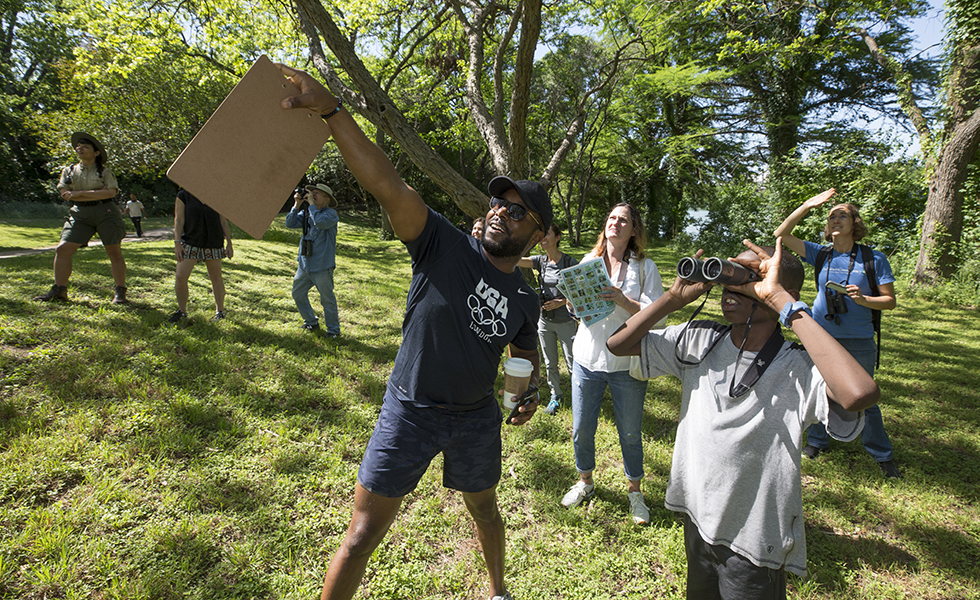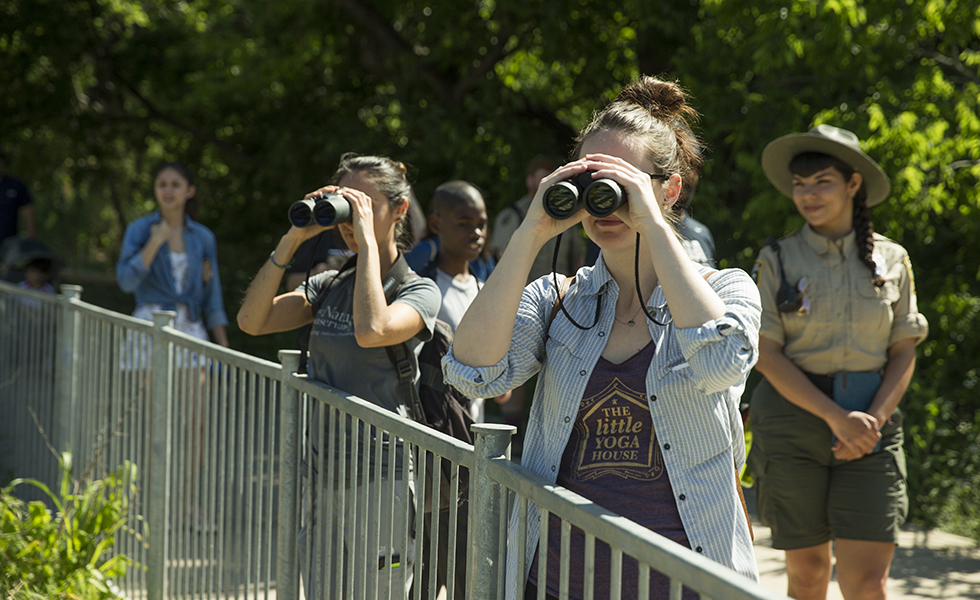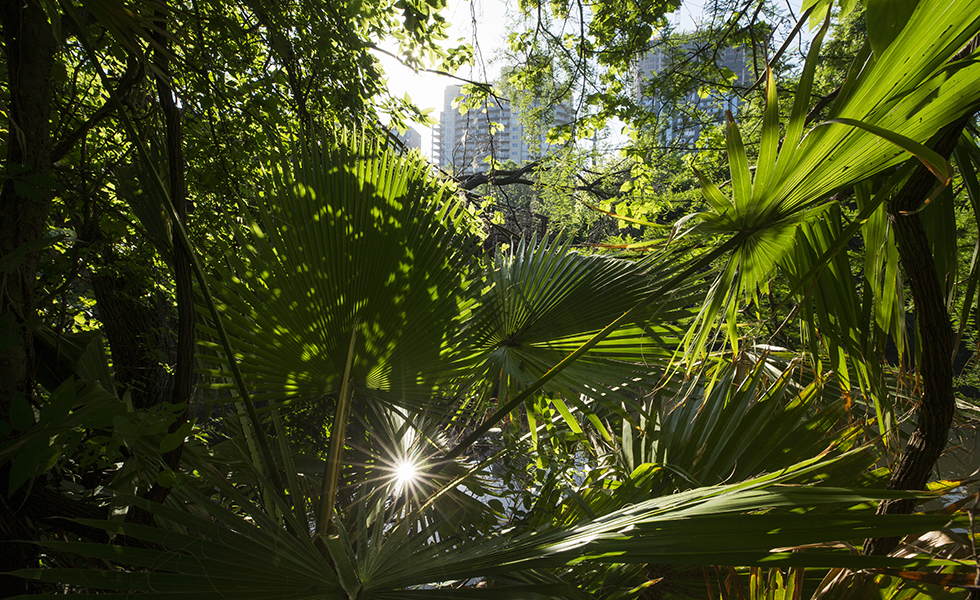This month, as we continue to struggle with the realities of a global pandemic—and the cooped-up existence it’s brought forth—the arrival of the annual City Nature Challenge (CNC) offers a welcome reprieve. The worldwide community science competition, which aims to document biodiversity around the globe, is a chance for a restorative communing with Mother Nature.
In years past, regional CNC teams would fan out across their area’s nature-rich hot spots, competing to document the most species, while being motivated with live scoreboard updates. But this year, given social distancing precautions, organizers are simply encouraging participants, working in “quaran-teams,” to record what they can, even if it’s in their own backyard.
Residents and professional scientists can document and capture photos of flora and fauna where they live using the app iNaturalist, developed by National Geographic and the California Academy of Sciences. Citizen scientists can record observations on the app from April 24 to 27. From April 28 to May 3, professional researchers will identify animals and plants that were not captured during the open collection period.
“This year we want to celebrate life where life is challenged,” says Jaime González, the urban conservation programs manager for the Nature Conservancy in Houston and is helping to lead the Houston-Galveston CNC. “We want to create unity around something that is fulfilling to everyone, which is nature.”
The worldwide challenge began in 2016 in an attempt to “excite people about the biodiversity around them and to capture data on wild animals,” González says.

In Houston, the regional CNC is coordinated by the Nature Conservancy of Texas and the Houston Museum of Natural Science. A Houston-Galveston team includes volunteers and staff with the Galveston Bay Foundation, the Houston Audubon Society, and the Memorial Park Conservancy. There will also be teams in Austin, Dallas, and San Antonio.
Last year, the Houston-Galveston CNC won first place in the country for the number of species identified, observing 3,286 distinct species. More than 24,534 observations were captured in Harris County alone; across all participating metros in the state, the program saw more than 1,700 research-grade observations—observations that have GPS coordinates and have been identified by two seperate people—representing 129 species with the greatest conservation needs.
This year, CNC teams have planned a series of virtual events and lectures to teach people how to participate and use the iNaturalist app. Users can download the app and take a photo of their observed animal, insect, or plant to upload and share with other observers. The app can also suggest species to look for, informing users of what’s been found in nearby locations.
“Our goal for this year is two-fold,” González says. “One is to make it as safe as possible … but also to get people excited about what’s happening around them.”
Those who participate are encouraged to use the hashtag #backyardchallenge to connect with other community scientists as well as help others in the area identify species. The program seeks to democratize nature, especially for communities underrepresented in environmental and conservation conversations.
“We want to encourage everyone to have a place at the table,” says Tania Homayoun, a nature biologist with Texas Parks and Wildlife. “We want people to see science as an everyday part of their life.”

González says that the Houston-Galveston CNC has focused its outreach this year on organizations that connect with low-income communities and people of color. For example, the U.S. Fish and Wildlife Services’ Houston Urban Wildlife Refuge program specifically addresses barriers to nature by providing training and community service projects through after-school and summer programs in urban areas. And students at Furr High School in northeast Houston, where the student population is 80 percent Hispanic and 17 percent black, are participating in the CNC.
Nancy Brown, who provides environmental education in Houston with the U.S. Fish and Wildlife Service, says her agency has been working with Furr’s agricultural science program to get students and other young people engaged in nature conservation while preparing them to take leadership positions in environmental organizations that lack diversity.
She says the CNC program is just another “opportunity to engage a lot of different people with a lot of different interests.”
“Kids today love their smartphone, and [CNC] is a nice combination of the use of technology with nature,” Brown says. “And not everyone has access to that technology, but maybe they know somebody who does … it’s a good way to get a lot of different people who haven’t started from an interest in nature to get to that point.”

This City Nature Challenge could also offer a clearer view of how plants and animals—like the bushy bluestem or great egret—are fairing in polluted areas, offering a more holistic view of the area’s ecosystem so scientists can look at data in the future and potentially “see where [leaders] can put in corridors, small forests, prairies, and wetlands to ensure that the wildlife and plant life is enhanced,” González says.
“The data will reveal patterns of where species are,” González says. This year, the silver lining of restricted mobility “would be collecting data from places that we have not focused on.”
In the past, participants would flock to state parks to observe species. Under new mandated restrictions, parkgoers will be required to wear face masks and gather in groups no larger than five people, so this year, the CNC is encouraging participants to look in their own backyards and neighborhoods to document nature. “What are the moths you’re finding on the side of your building? What is hanging out around your porch light at night? Some of the weeds may be growing in the median by your mailbox or on the side of the road,” Homayoun says. “This gives a bigger picture about some of the things happening out there.”
The goal is to get those who aren’t as connected with their natural surroundings to think about the biodiversity around them.
“We might see a massive surge in folks cataloging their neighborhoods,” says González, who grew up in the northern Houston area of Aldine, where 30 percent of households live below the poverty line. He says he didn’t have the luxury of camping but did have access to the wildlife at small local parks. He says he hopes “to get a lot more people interested in the long-term biodiversity health in our communities and how that’s tied to health and human welfare.”
Read more from the Observer:
-
State Employees Criticize Texas’ Uneven Approach to Worker Safety Amid COVID-19: A slow, patchwork response to COVID-19 has jeopardized worker safety for some of Texas’ lowest-paid public employees.
-
COVID-19 Cases Now Tied to Meat Plants in Rural Texas Counties Wracked with Coronavirus: The outbreaks, which are being investigated by the state health agency, represent the first reported cases of the virus inside Texas meatpacking plants, and are in rural areas where medical resources are already stretched thin.
-
Spinning Their Wheels: Dallas’ paltry public transit system makes owning a car all but required. So as the metroplex booms, many low-income residents are shut out of jobs and services they need.







